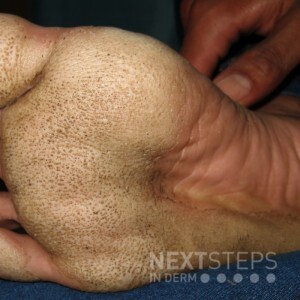
The correct answer is A. Pitted keratolysis.
Pitted keratolysis is caused most commonly by Kytococcus sedentarius. It is typically characterized by shallow 1- to 3-mm pits on the plantar surface of the feet. Malodor and hyperhidrosis are common. On high power, thin rods or cocci are seen on the surface of the cornified layer. It is typically treated by topical erythromycin, clindamycin, or benzoyl peroxide.
Tinea pedis typically presents with diffuse, erythematous plaques with scale on the soles and, often, painful fissures between the toes. Less often, patients describe vesicular or ulcerative lesions. Pits are not typically seen. Diffuse palmoplantar keratoderma is characterized by even, thick, symmetric hyperkeratosis over the whole palm and sole. Arsenical keratosis is a precancerous dermatosis seen in patients with chronic arsenic toxicity. It is characterized by corn-like, yellowish, hyperkeratotic papules and plaques, primarily affecting the palms and soles.
References:
Odom RB, James WD, Berger TG. Andrews Diseases of the Skin, 9th ed. Philadelphia: W. B. Saunders; 2000.
